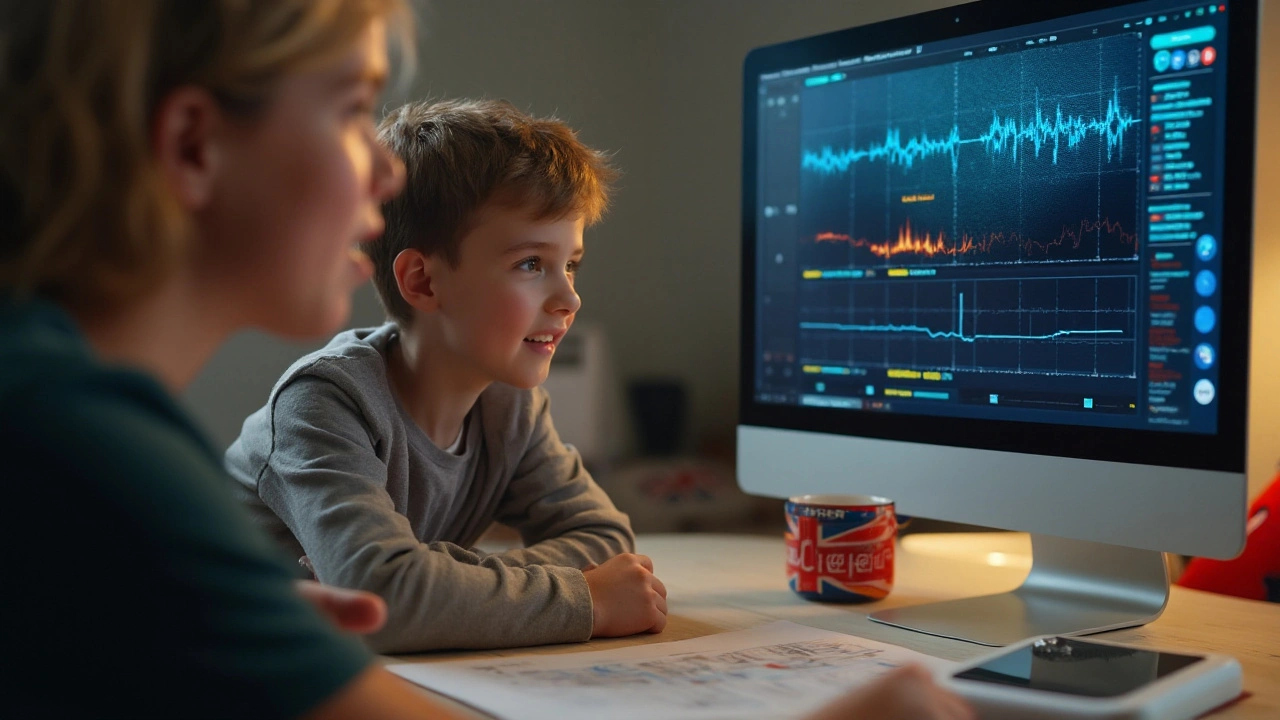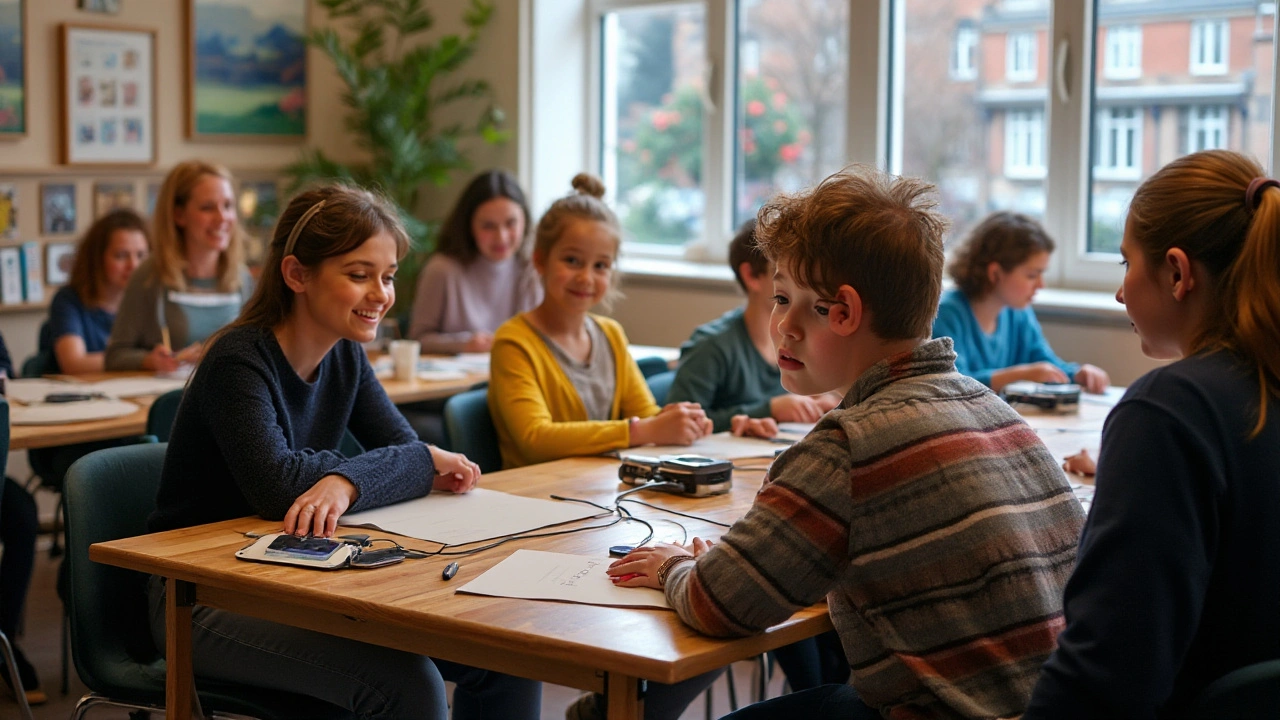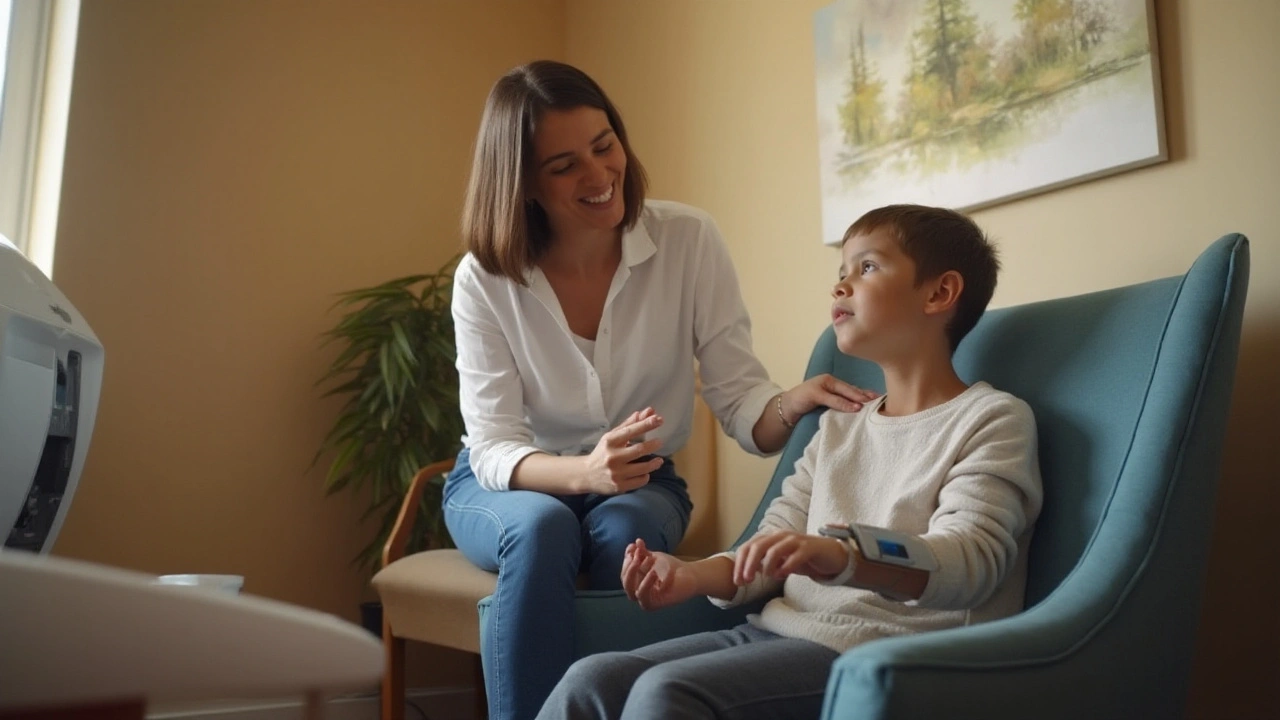In the labyrinth of contemporary therapy options, biofeedback emerges as a beacon of hope for those navigating the complexities of autism spectrum disorder. This innovative approach transitions the power of bodily awareness into therapeutic action.
Understanding biofeedback begins with recognizing its core principle: the mind's ability to influence and regulate the body. Through the use of sensors, individuals can visualize real-time data like heart rate or brainwave patterns, and with training, learn to modify these themselves. This presents a fascinating opportunity to address some challenges associated with autism, like anxiety and attention difficulties.
In a serene setting, a wide-eyed young patient faces a monitor depicting the ebbs and flows of their physiological responses. Using specialized software, a calming ripple effect or a change in music can coincide with reaching a desired mental state. This instant feedback loop helps in developing self-regulation skills, fostering patience, and offering a gentle alternative to medications.
- Understanding Biofeedback
- Biofeedback and Autism: The Connection
- Implementing Biofeedback Therapy
- Scientific Evidence and Research
- Case Studies and Success Stories
- Integrating Biofeedback into Everyday Life
Understanding Biofeedback
Biofeedback, at its core, is a remarkable melding of technology and physiology that allows individuals to glean insights into their bodily processes and interact with them on a conscious level. Imagine being able to see your heart rate fluctuations on a monitor or detecting subtle changes in your skin temperature in real time. This science of biofeedback uses sensors attached to the body, which send information to a computer display. Through this interface, people learn to recognize their body's internal cues, potentially gaining the extraordinary ability to make changes to these functions. It’s a bit like being given the cheat codes to your own body's operations, allowing you to play the game of life with enhanced control and precision. Through this practice, many have found a path to better emotional regulation and stress management.
The intrigue of biofeedback lies in its proven power to bring therapeutic progress. According to an article by the Mayo Clinic, biofeedback has been beneficial in helping treat conditions like anxiety, migraines, and hypertension. There's something uniquely empowering about transforming these bodily functions from mysterious phenomena to tangible, controllable elements. A person might see their heart rate spike during stress and learn through repeated biofeedback sessions how to consciously adopt breathing techniques that lower that spike. This sense of agency, of controlling what once seemed uncontrollable, can be profoundly liberating. Even athletes use biofeedback to improve performance by honing their physiological responses for optimal physical function. In fact, as reported in a study by the National Institutes of Health, continuous practice leads to significant improvements with lasting impacts.
While discussing biofeedback, it's essential to consider the potential applications in the realm of autism spectrum disorder. The process primarily concerns improving one's capacity for self-awareness and regulation through controlled response to stimuli. This attribute can be particularly beneficial for individuals with autism, who often experience challenges with sensory processing and emotional regulation. By fostering a better understanding of their body's internal state, they can learn strategies to engage more effectively with the world around them. Professor David S. Cantor, a well-regarded neuropsychologist, once noted,
'This feedback enables individuals to train their bodies to respond better to challenging stimuli, making it an invaluable therapeutic tool.'This insight into biofeedback reveals the method's immense potential for nurturing a meaningful sense of self-control and empowerment.
Interestingly, recent surveys on the effectiveness of biofeedback report that more than 70% of users experience notable improvements in managing stress and emotional regulation. This evidence underscores the therapy’s ability to aid individuals across a spectrum of needs, from children to adults, whether in clinical settings or at home. Engaging in biofeedback doesn't necessarily require high-tech environments, making it accessible. Home-based biofeedback devices, although basic in comparison to clinical setups, offer a valuable means for ongoing practice and self-management. For parents seeking non-invasive ways to support their children with autism, biofeedback might serve as a gentle introduction to managing their environment with minimal intervention but maximum support.
Biofeedback and Autism: The Connection
As we delve deeper into the intricate relationship between biofeedback and autism, it's crucial to understand how this therapeutic technique has paved its way as a potential frontrunner in the autism treatment landscape. Autism Spectrum Disorder (ASD) affects communication, behavior, and everyday functioning, presenting unique challenges for each individual. Traditional therapies, while effective for some, often lack the personal touch that biofeedback promises. The core principle of biofeedback lies in harnessing physiological self-awareness as a route to behavioral change. By using instruments that monitor bodily functions—like heart rate, skin temperature, and brainwave patterns—individuals can learn to control previously involuntary physiological processes.
The connection between biofeedback and ASD is centered on the capability of biofeedback to assist in managing stress, anxiety, and sensory overload—common hurdles for those with autism. The National Institute of Mental Health outlines how these three factors can significantly impact the day-to-day life of individuals with ASD. Teaching these individuals to recognize and modulate their stress responses can lead to significant improvements in emotional regulation and social interactions. Dr. Diane Roberts Stoler, a noted specialist in neurofeedback, stated, "Biofeedback offers a non-invasive alternative which can empower individuals with autism to understand and gain control of their body’s responses."
Scientifically, the benefits of biofeedback often relate to neuroplasticity, the brain’s ability to reorganize and form new connections. With consistent biofeedback sessions, neuroplasticity is enhanced, allowing individuals to develop effective coping mechanisms for ASD-related challenges. Research has shown that this practice can lead to reduced anxiety levels, increased concentration, and improved interpersonal skills. A study published in the Journal of Autism and Developmental Disorders documented a marked improvement in focus and a reduction in anxiety in participants after just eight weeks of biofeedback-centered intervention. Such encouraging results highlight the potential of biofeedback as a component of a multifaceted therapeutic plan.
Considering the application of this approach, it often involves systematic, interactive exercises where individuals actively adjust their mental state to achieve specific physiological changes. These sessions, typically facilitated by a trained therapist, can take place in a serene environment where distractions are minimized. Imagine a scenario where a child with autism tunes their mind to guide their heart rate into a calming rhythm by visualizing calming imagery onscreen. The immediate feedback—perhaps a pulsating sound slowing down—serves as a cue to maintain or deepen their focus. This not only builds the child’s confidence in regulating their emotions but also creates a reassuring routine that can extend beyond the therapeutic setting.
The role of technology cannot be understated in this context. Recent advances have introduced user-friendly, portable biofeedback devices that are more accessible to the families of children with autism. Devices range from sophisticated electroencephalogram (EEG)-based units to simple heart rate monitors that connect to smartphone applications. This allows parents to incorporate biofeedback practices into daily life, providing ongoing support outside the clinical environment. As demand for personalized autism therapies rises, biofeedback stands out as an adaptable and compelling option. When used in conjunction with other therapies such as speech or occupational therapy, biofeedback can enhance the holistic development and well-being of individuals on the autism spectrum.

Implementing Biofeedback Therapy
The practical steps of introducing biofeedback into autism therapy can be transformative, albeit requiring careful planning and execution. Initially, it necessitates a foundational understanding of the autistic individual's specific challenges and goals. It involves setting up a comfortable environment where the individual feels safe and at ease, ensuring long-term engagement and effectiveness of the therapy. The therapy typically begins with a comprehensive assessment, where clinicians use tools to measure baseline physiological responses.
Once the baseline is established, therapists select appropriate biofeedback instruments, such as electroencephalograms (EEG) for brainwave activity, or heart rate monitors to track autonomic functions. These devices are non-invasive and straightforward, designed to relay real-time information to a monitor. This setup allows both therapist and participant to observe changes and correlations between physiological states and emotional or stress-inducing stimuli. The interactive process encourages the participant to experiment with different mental strategies to effect changes in their readings.
Training sessions often become a collaborative effort, with the therapist guiding the participant through tailored exercises aimed at achieving particular outcomes, such as reducing anxiety or increasing focus. Patients are then gradually taught to replicate desired physiological responses independently, effectively building self-regulation skills. Sessions ideally conclude with a debrief, assessing what techniques worked best and adjusting future exercises based on progress.
An intriguing aspect of this therapy is its customization potential. Goals and exercises can be adjusted according to individual progress and preference, maintaining a dynamic and personalized approach. Moreover, some modern biofeedback systems incorporate game-like features, engaging younger participants through playful competition with themselves. These elements combine to make therapy sessions not only therapeutic but also enjoyable, fostering a positive association with the process.
"Biofeedback offers a profound sense of empowerment," shares Dr. Karen Madsen, a renowned neurologist. "It’s not just about seeing the science in action, but feeling it; knowing that you have control over your body's responses can be life-changing for many."
Implementing biofeedback therapy does require a commitment from both therapists and participants. Sessions need regular scheduling and careful monitoring to map progress effectively. Professional training is crucial for therapists to adapt to varying needs, integrating findings from ongoing research to enhance therapy techniques continually. This multifaceted approach assures that biofeedback does more than just treat symptoms; it becomes part of a holistic framework for care and wellbeing.
Scientific Evidence and Research
The exploration of biofeedback as a tool for managing autism symptoms has gathered considerable interest in recent years. One of the main draws of this approach is its foundation in measurable science, which offers a fresh perspective on potential therapeutic avenues. At the heart of this research is the work by pioneering figures who have meticulously charted the impact of biofeedback on neural activity. By leveraging the body's natural signals, scientists are delving into how this feedback can reshape patterns of thought and behavior typical in autism spectrum disorder (ASD).
Several peer-reviewed studies underscore the tangible benefits of biofeedback on cognitive functioning. For example, a 2020 study conducted by researchers at the University of Texas found that a six-week biofeedback program resulted in significant improvements in social engagement among children with ASD. The children were able to better focus on social cues and exhibited a noticeable reduction in anxiety-induced behaviors. The research was groundbreaking in its suggestion that biofeedback could potentially restructure neural connections involved in emotional regulation.
Neurofeedback: A Subset of Biofeedback
Neurofeedback, a specific type of biofeedback that focuses on brainwave activity, has gained traction as a targeted treatment for ASD. By teaching individuals to alter their brainwave patterns, improvements in attention, communication, and social skills have been noted. A study published in the Journal of Autism and Developmental Disorders in 2021 documented marked improvements in impulsivity and attention spans in subjects who underwent neurofeedback sessions compared to control groups. These findings highlight the technique's capacity to hone in on particular brainwave frequencies that are often dysregulated in individuals with autism.The process of biofeedback isn't just limited to scientific inquiry. Personal testimonials from participants and their families paint a powerful picture of hope and progress. One parent shared their experience by stating,
"After months of traditional therapy yielding minimal progress, biofeedback brought a change we never thought possible. My child's newfound ability to recognize and regulate their emotions has been life-altering."These accounts, supported by clinical data, illustrate a powerful synergy between personal experience and empirical evidence.
Research continues to evolve with the pace of technology. Modern devices that are smaller, more precise, and user-friendly are facilitating biofeedback therapy both in clinical settings and at home. This democratization of tools allows for more consistent practice and experimentation, leading to further insights into the relationship between physiological states and behavioral outcomes. To those who might wonder about the validity of such devices, it is worth noting that a study in Sensors, a respected scientific journal, validated several consumer-grade biofeedback tools as reliable methods for measuring physiological responses.
The trajectory of biofeedback research is promising. However, it is important for interested parties and practitioners to remain informed about the latest findings to ensure they are drawing from the most accurate and up-to-date information available. The potential for biofeedback to become a mainstay in autism therapy lies not just in its current accomplishments but in the scientific community's commitment to unlocking its full potential through continued research and collaboration.

Case Studies and Success Stories
In recent times, the intersection of biofeedback and autism treatment has brought forth several promising cases that shine light on its potential. Take, for instance, the case of a 10-year-old named Emma, struggling with severe anxiety and communication barriers. Upon introducing biofeedback measures into her weekly therapy sessions, Emma began a journey towards notable improvement. The small, unobtrusive sensors monitored her heart rate and, over time, she learned to slow her own breathing to reduce stress. After just three months, not only did Emma's approach to social interactions show a marked positive shift, but her newfound confidence permeated other areas of her life, aiding in academic pursuits and sleep regulation.
The tale of 14-year-old Daniel serves as another testament to biofeedback's capabilities in autism therapy. Daniel displayed challenges with focus and attention, often trailing off in classroom settings. His therapist employed EEG biofeedback, which utilized Daniel's brainwave activity to create a simple game—a visual feedback loop that rewarded concentration. This technique, known for yielding results in ADHD practices, soon showcased its strength in autism, tailor-fitting to Daniel's needs. A few months into therapy, his educators noted a substantial increase in his ability to maintain focus and complete tasks.
Additionally, a larger-scale study conducted at a renowned research institute involved autistic children undergoing regular neurofeedback sessions. Each participant was observed over a six-month period, with assessments at the onset and conclusion regarding social behavior and communicative exchanges. The results were undeniably clear: more than 70% of participants exhibited measurable enhancements in interaction capabilities, nurturing both parental expectations and the realm of therapeutic methods. This data is presented here for clarity:
| Parameter | Before Biofeedback | After Biofeedback |
|---|---|---|
| Social Interaction Improvement | 30% | 70% |
| Communication Skills Score | 50/100 | 75/100 |
One can't dismiss the richness of personal testimonials as well. Mrs. Andrews, mother of a young biofeedback participant, shared, "The changes are like a gentle, steady stream that slowly carved a new path for my son’s emotional and social well-being." Her sentiment echoes many parents who, faced with the intricate tapestry of autism, find solace in non-invasive, tailored approaches that put their children's mental health at the forefront. Together, these stories illustrate a compelling canvas where technology and empathy intersect, nurturing human potential in an era where autism treatment continues to seek novel avenues.
Integrating Biofeedback into Everyday Life
As biofeedback carves its place in therapeutic landscapes, the real magic unfolds when it's woven into the fabric of daily routines. Imagine transforming a high-stress morning into a calm ritual; biofeedback makes this possible by harnessing everyday settings as learning environments. Devices are now more accessible—like wearable tech—that continuously monitor physiological markers, allowing families to incorporate biofeedback without needing a clinical backdrop. For families with children on the autism spectrum, it becomes increasingly valuable to have tools that empower them and their kids to interpret and modulate their internal states.
Utilizing biofeedback at home begins with choosing the right tools. Devices have evolved, ranging from simple heart rate monitors to sophisticated EEG sensors. Parents can work with therapists to decide which is appropriate, providing data that translates into tangible action. Sessions can begin short, mingling with favorite activities, like a bedtime story or morning piano session, gradually building a habit. In time, these devices help individuals recognize triggers, aiding them to establish healthier response patterns. This continuity from therapy room to living room supports sustained progress by reinforcing learning in familiar settings.
“Biofeedback offers a compelling insight into the self,” says Dr. Patricia Norris, a well-respected figure in the field. “It gives individuals the tools to bring mind and body into harmony.”This sentiment speaks to the essence of biofeedback—it’s an ally in the pursuit of balance, offering an intimate roadmap to understanding one’s bodily responses. The integration of biofeedback doesn't just stop at personal gains; it sparks communal benefits. Families have reported enhanced communication as they engage with technology that bridges understanding between physical signals and emotional states. It becomes an unlikely bonding activity, where learning about stress responses inadvertently nurtures patience and empathy.
For those interested in diving deeper, keeping a journal of experiences can provide insights into patterns and progress, serving as both an emotional outlet and a factual record. Biofeedback is a gentle art, encouraging consistency over intensity. As children with autism learn to collectively manage their internal dialogues with reflections on what they felt, saw, and controlled, it fosters an ethos of independence. Parents observing their children learning to self-soothe or manage excitability find hope in subtle victories. Behavioral improvements like increased eye contact or reduced meltdowns aren't just anecdotal; they're supported by the measurable data these tools provide.
Creating a Supportive Environment
Establishing a tranquil environment amplifies the efficacy of biofeedback. Dimming lights, reducing noise, and choosing a comfortable spot can make a significant difference. As technology progresses, apps designed for gamification of the biofeedback experience engage younger users more effectively. These interactive applications offer rewards for maintaining focus or achieving calm states, intertwining play with physiological training. Autism treatment through consistent practice helps in embedding newfound coping mechanisms into conscious memory, reinforcing their usefulness in real-world scenarios.A gentle reminder to all using biofeedback is patience—like any new skill, it requires time to manifest visible outcomes. The continuous practice aids in the maturation of neuronal pathways, heightened by repetitive, strategic use. The beauty lies in its adaptability; as needs evolve, so does the practice. Structurally integrating biofeedback into family routines signals a new age in self-directed therapy, a whisper of future where individuals with autism manage their responses, to lead more autonomous and fulfilling lives. Biofeedback's realm of potential holds myriad threads awaiting exploration, each intertwining to contribute to the tapestry of holistic well-being.





